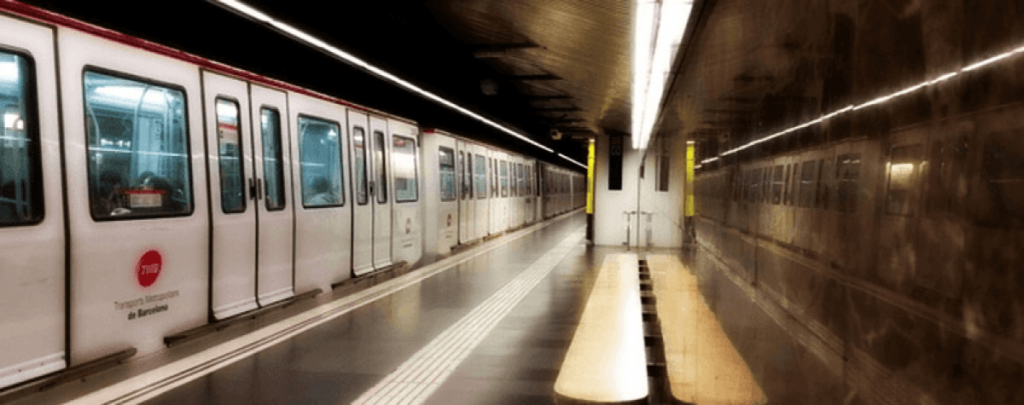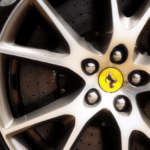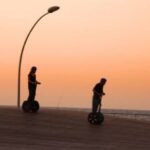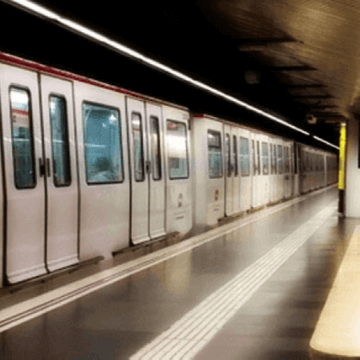
Complete guide to using the Metro in Barcelona
EVERYTHING ABOUT THE BARCELONA SUBWAY SYSTEM
The metro of Barcelona is one of the best ways to move around Barcelona. It takes you pretty much everywhere in a relatively short time and it is cost-efficient. The average time between stops is about 2 minutes, with a frequency of 2.5 minutes between trains (more in the weekends, holidays and at night). The Barcelona metro is also one of the oldest subway systems in Spain (but don’t worry: the models of the carriages are updated regularly and the stations are also improved on regular basis).
The origins of the Barcelona Metro date back from 1863, when the Ferrocarril de Barcelona a Sarria railway was innaugurated – now this line belongs to one of the two companies composing the Barcelona underground networks, FFCC (Ferrocarrils de la Generalitat de Catalunya). In 1920 was created Barcelona Metro, with a line connecting Plaça Catalunya and Plaça Lesseps, now part of the L3 run by TMB (Transports Metropolitans de Barcelona, the other company running the Barcelona subway system), and in 1922 came Metro Transversal, connecting Plaça Catalunya with Plaça Espanya (now L1 of the TMB subway).
Opening hours of the Barcelona underground
1
Normal schedule of the subway lines
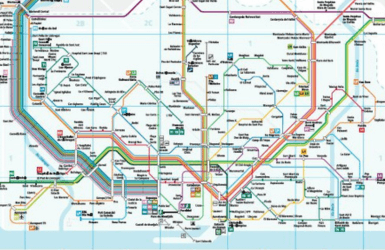
The Barcelona metro runs every day of the year. The service starts at 5AM until midnight. On Fridays and the evening before a bank holiday, the subway stays open two additional hours, until 2AM. And in the weekends, the metro runs non-stop from 5AM on Saturday morning until Sunday at midnight - so 43 hours total. However, if you are planning to use the metro late at night be aware that some subway entrances from the street and also some line connections inside the stations might be closed earlier, forcing you to take a detour to find the right way to get to your desired platform.
2
Exceptions to take into account
- Stations of Mas Blau, Mercabarna i Parc Logístic (L9 Sud): open daily from 5AM to midnight.
- Stations of ZAL | Riu Vell, Ecoparc i Port Comercial | La Factoria (L10 Sud): open daily from 5AM to midnight.
- December 24 (Christmas Eve): All stations, included the ones above, close at 11PM.
- December 31 (New Year’s Eve): Service runs all non-stop from 5AM of December 31 until midnight of January 1st, for a total of 43 hours of service.
Barcelona metro lines and zones
The Barcelona subway system runs completely within the Zone 1 of the Integrated Fare System, except for the 2 train stations at the Barcelona Airport, which are considered an exception. Zones 2 to 6 are serviced by suburban trains fun by Renfe-Rodalies and FGC, and buses from several different companies.
3
TMB metro lines
Referred by the locals as “el Metro”, the lines of the Barcelona subway system run by TMB are 8, each of them with a number and a color assigned. Locals use the number to call each line, although lines 1 to 5 are also often called by their color. There’s a total of 165 stations, most of them inside Barcelona city, but some other in nearby suburbs as well. You can find updated TMB maps here.
L1 (red line)
Number of stations: 30 stops, along 20.7km / 12.8mi
End stations: Hospital de Bellvitge and Fondo (connecting the cities of L’Hospitalet de Llobregat and Santa Coloma de Gramenet through Barcelona).
Use it to get to: Plaça Catalunya (city center, bottom of Passeig de Gracia and top of La Rambla), Urquinaona (Palau de la Música Catalana), Espanya (Hill of Montjuic), Arc de Triomf (1888 World Fair, Ciutadella Park), Glories (Encants flea market).
Type of route: Double track, underground except for the section between Mercat Nou and Santa Eulalia. Semi-automatic trains with driver.
Future extensions: There’s a plan to extend this line to El Prat Estacio from Hospital de Bellvitge, and to Badalona Pompeu Fabra from Fondo.
L2 (purple or pink line)
Number of stations: 18 stops, along 13.1km / 8.1mi
End stations: Paral·lel and Badalona Pompeu Fabra (connecting Barcelona with Sant Adria del Besos and Badalona).
Use it to get to: Paral·lel (connection with the Funicular of Montjuic, Sant Pau del Camp monastery), Sant Antoni (food market and hipster district), Universitat (city center), Passeig de Gracia, (2 blocks from Casa Batllo), Monumental (old bullring), Sagrada Familia (Gaudi’s church), Encants (flea market).
Type of route: Double track, completely underground. Semi-automatic trains with driver.
Future extensions: There’s a plan to extend the line from Sant Antoni towards Zona Franca, where a connection with the L9 track would allow the trains to continue to the airport. Extending the line from Badalon Pompeu Fabra to the Hospital of Can Ruti is also a possbility being discussed.
L3 (green line)
Number of stations: 26 stops, along 20.7km / 11.4mi
End stations: Zona Universitaria and Trinitat Nova (the entire itinerary runs within Barcelona city).
Use it to get to: Zona Universitaria (FC Barcelona Stadium), Palau Reial (Gaudi’s Dragon Gate), Sants Station (AVE train to Madrid and most suburban train lines), Espanya (Montjuic Hill and Magic Fountain), Paral·lel (Funicular to Montjuic and Monastery of Sant Pau del Camp), Drassanes (bottom of La Rambla, Columbus statue, Maritime Museum and Port Vell), Liceu (opera house, Boqueria Market, Palau Guell), Catalunya (city center), Passeig de Gracia (in front of Casa Batllo), Diagonal (one block from Casa Mila), Fontana (squares of the Gracia district and Casa Vicens), Lesseps and Vallcarca (closest stops to Park Guell), Mundet (Parc del Laberint)
Type of route: Double track, completely underground. Semi-automatic trains with driver.
Future extensions: There’s a project to connect it with Trinitat Vella in the North end, and take it outside of the city through the Southern suburbs all the way to Sant Feliu de Llobregat.
L4 (yellow line)
Number of stations: 22 stops, along 17.3km / 10.7mi
End stations: La Pau and Trinitat Nova (the entire itinerary runs within Barcelona city).
Use it to get to: El Maresme Forum (Blue Building and CCCIB), Poblenou, Ciutadella-Vila Olimpica (beaches), Jaume I (Gothic Quarter, Born district and Picasso Museum), Urquinaona (city center and Palau de la Musica), Passeig de Gracia (2 blocks from Casa Batllo).
Type of route: Double track, underground except for the section between Mercat Nou and Santa Eulalia. Semi-automatic trains with driver.
Future extensions: There’s a project to extend the line from La Pau to Sagrera with three more stations.
L5 (blue line)
Number of stations: 27 stops, along 18,9km / 11.7mi
End stations: Cornella Centre and Vall d’Hebron, connecting the suburb of Cornella de Llobregat with Barcelona via L’Hospitalet and Esplugues de Llobregat.
Use it to get to: Collblanc (FC Barcelona stadium), Sants Estacio (AVE train to Madrid and most suburban train lines), Diagonal (two blocks from Casa Mila), Sagrada Familia, Sant Pau | Dos de Maig (Hospital de Sant Pau).
Type of route: Double track, underground except for occasional openings near Can Boixeres station. Semi-automatic trains with driver.
Future extensions: There’s no plans to extend the line: it’s considered final.
L9
Number of stations: 9 stops on its Northern section (L9N) and , 15 stops in its Southern section (L9S), with a total of 11.7km / 7.2mi.
End stations: La Sagrera and Can Zam (L9S, connecting Barcelona and Santa Coloma de Gramenet), Zona Universitaria and Aeroport T1 (L9N, connecting Barcelona with the airport via l’Hospitalet and El Prat de Llobregat).
Use it to get to: Barcelona Airport, Fira and Europa | Fira (Trade Show and congress venues), all three on L9S.
Type of route: Double track, underground except for a section near Zona Franca. Fully automatic trains without a driver.
Future extensions: The connection between L9S and L9N is under construction and should be finished by 2029, going through Sarria, Lesseps and Guinardo.
L10
Number of stations: 6 stops on its Northern section (L10N) and , 11 stops in its Southern section (L10S), with a total of 11.1km / 6.8mi.
End stations: Collblanc and ZAL | Riu Vell (L10S, connecting Barcelona and L’Hospitalet de Llobregat), La Sagrera and Gorg (L9N, connecting Barcelona and Badalona).
Use it to get to: industrial district such as ZAL, Zona Franca and Ciutat de la Justicia.
Type of route: Double track, underground except for the section between Zona Franca and ZAL | Riu Vell which runs outdoors on top of a viaduct. Fully automatic trains without a driver.
Future extensions: The connection between L10S and L10N is under construction and should be finished by 2029, going through Sarria, Lesseps and Guinardo, sharing tracks with the L9.
L11
Number of stations: 5 stops over 2.3km / 1.4mi.
End stations: Trinitat Nova and Can Cuias, both within Barcelona city.
Use it to get to: You aren’t likely to need to access this part of the city if you are visiting Barcelona.
Type of route: Single track except at the Torre Baro | Vallbona station, completely underground. Fully automatic trains without a driver.
Future extensions: Despite the original plan of connecting it with other suburban train lines, the projects are so far stopped.
4
FFCC metro lines
L6 (Sarrià)
Number of stations: 8 stops, along 4.7km / 2.9mi End stations: Plaça de Catalunya and Sarria, both within Barcelona. Use it to get to: Plaça Catalunya (city center), Provença (two blocks from Casa Mila), Sarria (quaint district famous for a bar with great patatas bravas) Type of route: Double track, completely underground. Semi-automatic trains with driver. Future extensions: The itinerary of this line is final.L7 (Avinguda Tibidabo o Balmes)
Number of stations: 7 stops, along 3.9km / 2.4mi End stations: Plaça Catalunya and Av. Tibidabo, both within Barcelona. Use it to get to: Plaça Kennedy and from there transfer to buses taking you to Torre Bellesguard, Cosmocaixa or the Tibidabo Amusement Park. Type of route: Double track, completely underground. Semi-automatic trains with driver. Future extensions: The itinerary of this line is final.L8 (Llobregat)
Number of stations: 11 stops, along 11.8km / 7.3mi End stations: Plaça Espanya and Moli Nou – Ciutat Cooperativa, connecting Barcelona with the suburbs of L’Hospitalet, Cornella and Sant Boi de Llobregat. Use it to get to: The Fira Gran Via congress venue. Type of route: Double track, 73 % underground. Semi-automatic trains with driver. Future extensions: The works to connect Plaça Espanya with Gracia via Hospital Clinic have just started and should be completed by 2030.L12 (Reina Elisenda)
Number of stations: 2 stops, only 0.6km / 0.3mi End stations: Sarria to Reina Elisenda, this line is nowadays only a shuttle between these two stations in Barcelona. Use it to get to: Monastery of Pedralbes. Type of route: Double track, completely underground. Semi-automatic trains with driver. Future extensions: Several plans to extend this line have never been approved.Cost and tickets of the subway in Barcelona
5
Types of tickets
| Ticket | # Trips | Shareable | Expiration | Airport | Format |
|---|---|---|---|---|---|
| Single* | 1 | No | 75 minutes | No | Cardboard |
| Airport ticket | 1 | No | 75 minutes | Yes | Cardboard |
| T-Casual | 10 | No | Next fare changes | No | T-Mobility |
| T-Usual | Unlimited | No | 30 days | Yes | T-Mobility |
| T-Jove** | Unlimited | No | 90 days | Yes | T-Mobility |
| Hola Barcelona | Unlimited | No | 48, 72, 96 or 120 hours | Yes | Cardboard |
| T-Dia | Unlimited | No | 24 hours | 1 round trip | Cardboard |
| T-Familiar | 8 | Yes | 30 days | No | T-Mobility |
| T-Aire*** | 2 | Yes | Day of purchase | No | Cardboard |
* It can’t be used to transfer to other types of public transportation (except if you bought it for the TMB lines, then you can transfer to the Funicular de Montjuic from L2 and L3).
** Only for people under 30yo: requires proof of age (Spanish ID card or passport)
*** Only available on days of traffic restrictions due to high airpollution.
Other tickets for residents
Some residents are entitled to specific tickets at free or discounted rates:
- T-16 for kids aged 4 to 16
- T-4 for disabled and senior people owning a Targeta Rosa card
- Metropolitan Pink Card
- T-usual, T-Jove and T-70/90 FM/FN, for accredited large and single-parent families.
- T-Acompanyament and Passi Metropolita d’Acompanyant, for disabled people that require assistance to travel. With this ticket their companion travels for free.
- T-Escolar, for local school groups with their teachers.
- T-Verda, for residents that decommission a vehicle without an environmental certificate.
6
Where to buy Barcelona metro tickets?
- Ticket machines at the stations: All the cardboard tickets. The machines “speak” English: just select the British flag to switch language. They take credit cards (but not contactless and you’ll likely be asked for your PIN number), and some also take cash.
- Turist offices: Only the Hola Barcelona cards.
- TMB information and customer service offices. Hola Barcelona cards and passes with specific requirements (age, family size, handicaps…). Find them in the stations of Diagonal, La Sagrera, Sagrada Familia, Universitat.
- T-Mobilitat kiosks. Registration, purchase and recharge of T-Mobilitat. Find them in the stations of Arc de Triomf, Espanya, La Sagrera, Lesseps and Torrassa. Appointments need to be scheduled in advance.
- T-Mobilitat. Not as easy as it should be, you first have to go to the TMB website and sign in (you can use Google, Facebook or Apple ID), and then you’ll need to create a T-Mobilitat account. The PICA verification requires you to have a Spanish DNI or NIE, the non-PICA verification allows you to enter a valid and not-expired passport number and upload a picture of it so it can be manually approved within 24 hours. You’ll have to choose if you want your T-Mobility card to be a plastic card sent to your home, or a virtual app (Android or IOS phones with NFC only) – there’s a small fee for each option. Either way you’ll then be able to use the T-Mobilitat app to purchase and recharge tickets.
- Other websites. Hola Barcelona is sold by multiple authorized distributors online.
Using the metro in Barcelona
7
Entering the station
Beware: while in general all entrances allow you to access both platforms of a line, there’s one station where the platforms aren’t connected. Liceu on L3 has two staircases leading to the trains heading to Zona Universitaria (those on the side of the street right in front of the Boqueria Market or the Liceu Opera House – the Raval District side), and two staircases leading to the trains heading to Trinitat Nova (the ones on the Gothic Quarter side of La Rambla). If you happen to enter the wrong platform you’ll have to take the next train and go to the next stop to switch platforms unless you want to pay again (or you have a ticket with unlimited rides).
8
Validating your ticket
Cardboard tickets are introduced through a slot in the front of the machine, and need to be retrieved from another slot at the top of it – otherwise the door won’t open. T-Mobility cards need to be scanned with a sensor on top of the machine (make sure your FNC is enabled on your phone if you are using your phone as support for your virtual card). Also don’t get too close to the door as sometimes they don’t open when you are too close: if that happens, just step back and it’ll open.
9
At the platform
In the FGC network several lines might be sharing the same track. In both cases, there’s screens announcing the line and final destination of the next trains, and the time left for the trains to arrive. In the TMB platforms where only one line and direction uses the track, there’s also counters displaying how long until the next train arrives, as well as other announcements. You’ll often find food, beverages and technology gadgets vending machines at the platforms. There’s also usually benches to seat while you wait.
10
Inside the metro carriages
There are seats reserved for seniors, parents holding babies and people with walking issues. They are marked with stickers on the windows over them and they are of a different color than the rest of the seats. Most locals aren’t paying much attention, though: if you are entitled to a reserved seat and nobody is standing up to offer their seat to you, don’t be shy to ask.
There are screens and sound signals telling you what’s the next station: very convenient! And at each end of the carriage, you’ll see small screens displaying arrows that show you which side of the carriage has doors opening at the next stop. Once it stops, remember that in the Barcelona subway system the doors won’t open until you action the button or lever: if you are standing in front of the door waiting for it to open, an angry Barcelonan will do it for you and push you out of their way (or you’ll miss your stop if no one else is getting out!)
11
Leaving the subway station
If you aren’t sure what exit you need to take, you’ll find maps of the area at the center of each platform, and also at the entrance halls of the station (after having exited the turnstiles). There’s stairs leading back up and often escalators. If using escalators, be mindful of other travelers: the Barcelona metro system etiquette says that if you are not going to walk up the escalator, you have to stand to the right to let passengers that are in a hurry walk up. Same thing if you are a couple or a group and you are not walking up, remember not to block the way.
On the TMB stations you won’t need to validate your ticket again to exit the station, however, don’t throw it away until you are back in the street, as occasionally there are ticket controls to catch people who sneak in the Barcelona metro system without paying. On some FGC you must validate again your ticket to be allowed to leave the station, but it won’t count as another ride.
Is the Barcelona metro system safe?
Unfortunately, pickpockets often lurk in the Barcelona subway. They act in the platforms, inside the carriages and at the escalators, so it’s important to be cautious and keep an eye on your belongings. Make sure to check out our post about pickpockets in Barcelona to learn more about their tactics and how to stay safe. Other than that, the Barcelona subway is safe even at night and violent crime is very very rare.
Is the metro of Barcelona accessible?
Have you ever used the Barcelona metro system?
Marta
RESEARCHING FOR A TRIP IS TIME-CONSUMING…
Need more inspiration?
Our 100% FREE Barcelona Collection will give you everything you need to organize the trip of your lifetime to Barcelona.
BEST INSIDER TIPS FROM THE PROS!


